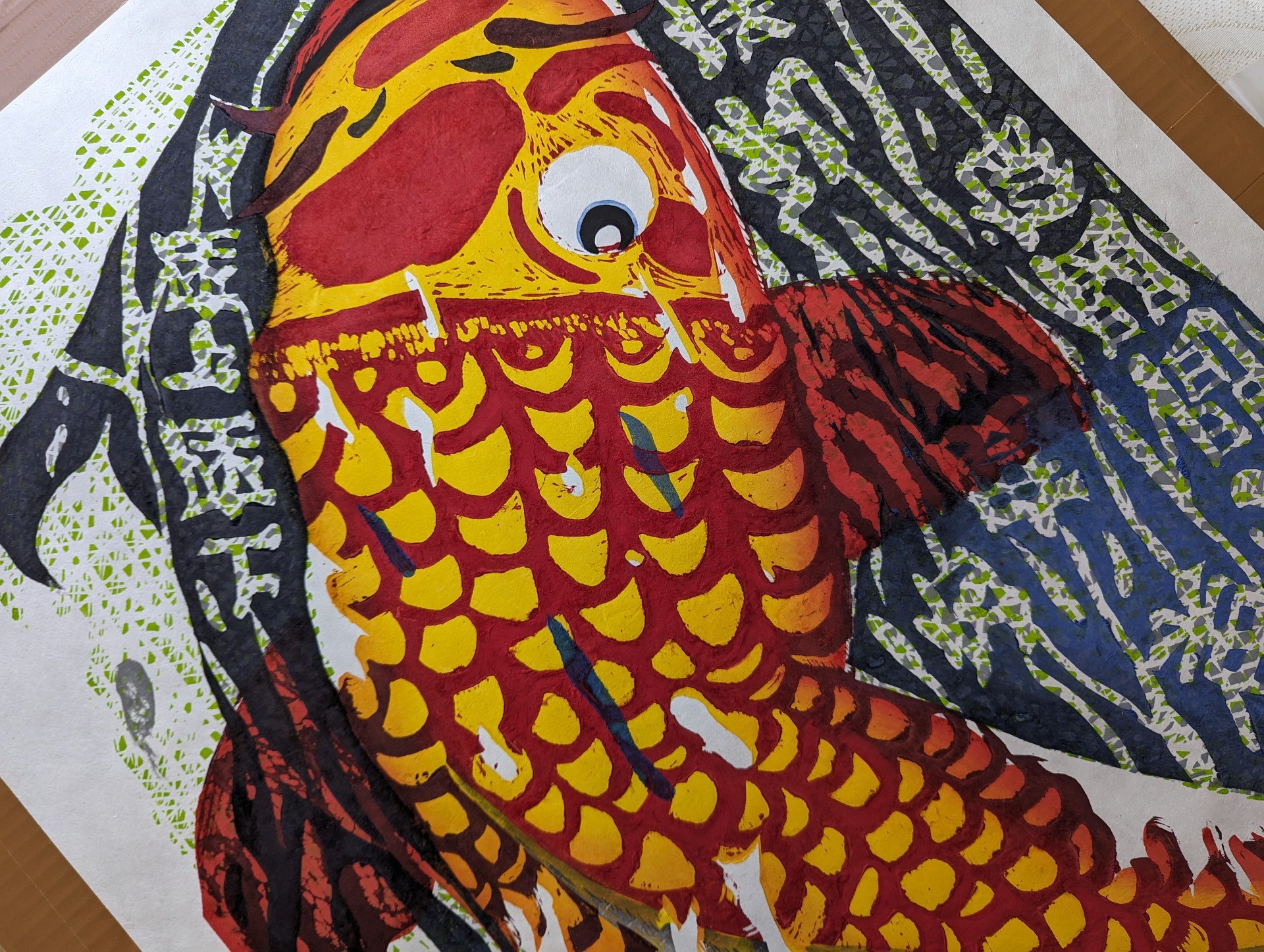





Misa Tsuchiya - 滝登り (Swimming up a Waterfall)
Title: 滝登り (Swimming up a Waterfall). Ed. 8/10.
Artist: Misa Tsuchiya (1993-Present).
Signed & Dated: Signed, titled, & editioned in pencil to plate. Published 2022.
Medium: Water-based Woodblock Print. Printed on "Tosa Washi No. 1". 100% Kozo, Kochi Prefecture.
Paper Sheet: H: 86.00cm x W: 60.50cm.
Condition: Mint. Direct from artist. Please contact for any further questions/photos.
Notes: A masterpiece. Limited to a small edition of 10, Misa Tsuchiya "Swimming up a Waterfall" draws from the ancient Chinese legend of “Dragon’s Gate”: A story of one determined koi swimming upstream & traversing Dragon's Gate waterfall. Overcoming an impossible challenge, the koi is transformed into a golden dragon as a reward for its achievement. A story signifying perseverance & strength - becoming one of the most auspicious symbols of success in Japan.
Misa Tsuchiya notes: “日本社会は動きの一つ一つが出世道。 『ルール』を守れば出世に近づく。 登れなければ谷底までまっさかさま。 日本の錦鯉は、みんな一心不乱に登っていく。” (“To be successful in a Japanese organisation, you need to follow detailed "Japanese rules". If you follow the "rules", you will be closer to success. If you can't climb, you'll be upside down at the bottom of the valley. Japanese Nishikigoi climb with great effort”). Beautifully woven into the rippling waters of the image, Tsuchiya summarizes the rules and words that Japanese people must overcome in order to succeed. Written in Edo-moji Japanese lettering (bringing good fortune), & listed in relative order of difficulty from the top of the waterfall downward:
蹴 (Kick): 出世するには、最終的に元々ポジションにいる人を 蹴落とさなければならないので 「蹴落とす」の 「蹴」を入れた。The 'kick' in 'kick down' is included because、 in order to move up, you eventually have to kick down the person who originally occupies the position.
上座下座 (uwaza kōza): Seating hierarchy in Japan. "上座" (uwaza) is a higher seat of honor, while "下座" (kōza) is less important. Seating order based on age, rank, status. Seen in formal settings, reflects social roles.
礼儀: (Etiquette).
人間間係: The phrase "人間間係" (jinkan kankei) highlights the significance of interpersonal relationships. In Japan, building and maintaining strong relationships ("間係" or "kankei") is a crucial aspect of achieving success.
忖度: "Sontaku" is anticipating and responding to others' intentions without explicit communication, valued in Japanese culture, especially with superiors. 成果: “Seika” signifies achieved outcomes or results. ストレス: Stress.
お酌: “Oshaku” refers to the act of pouring drinks for others, often in a social or business context. In relation to Japanese success, skillful "お酌" demonstrates hospitality and social grace.
Misa Tsuchiya - 滝登り (Swimming up a Waterfall)
Title: 滝登り (Swimming up a Waterfall). Ed. 8/10.
Artist: Misa Tsuchiya (1993-Present).
Signed & Dated: Signed, titled, & editioned in pencil to plate. Published 2022.
Medium: Water-based Woodblock Print. Printed on "Tosa Washi No. 1". 100% Kozo, Kochi Prefecture.
Paper Sheet: H: 86.00cm x W: 60.50cm.
Condition: Mint. Direct from artist. Please contact for any further questions/photos.
Notes: A masterpiece. Limited to a small edition of 10, Misa Tsuchiya "Swimming up a Waterfall" draws from the ancient Chinese legend of “Dragon’s Gate”: A story of one determined koi swimming upstream & traversing Dragon's Gate waterfall. Overcoming an impossible challenge, the koi is transformed into a golden dragon as a reward for its achievement. A story signifying perseverance & strength - becoming one of the most auspicious symbols of success in Japan.
Misa Tsuchiya notes: “日本社会は動きの一つ一つが出世道。 『ルール』を守れば出世に近づく。 登れなければ谷底までまっさかさま。 日本の錦鯉は、みんな一心不乱に登っていく。” (“To be successful in a Japanese organisation, you need to follow detailed "Japanese rules". If you follow the "rules", you will be closer to success. If you can't climb, you'll be upside down at the bottom of the valley. Japanese Nishikigoi climb with great effort”). Beautifully woven into the rippling waters of the image, Tsuchiya summarizes the rules and words that Japanese people must overcome in order to succeed. Written in Edo-moji Japanese lettering (bringing good fortune), & listed in relative order of difficulty from the top of the waterfall downward:
蹴 (Kick): 出世するには、最終的に元々ポジションにいる人を 蹴落とさなければならないので 「蹴落とす」の 「蹴」を入れた。The 'kick' in 'kick down' is included because、 in order to move up, you eventually have to kick down the person who originally occupies the position.
上座下座 (uwaza kōza): Seating hierarchy in Japan. "上座" (uwaza) is a higher seat of honor, while "下座" (kōza) is less important. Seating order based on age, rank, status. Seen in formal settings, reflects social roles.
礼儀: (Etiquette).
人間間係: The phrase "人間間係" (jinkan kankei) highlights the significance of interpersonal relationships. In Japan, building and maintaining strong relationships ("間係" or "kankei") is a crucial aspect of achieving success.
忖度: "Sontaku" is anticipating and responding to others' intentions without explicit communication, valued in Japanese culture, especially with superiors. 成果: “Seika” signifies achieved outcomes or results. ストレス: Stress.
お酌: “Oshaku” refers to the act of pouring drinks for others, often in a social or business context. In relation to Japanese success, skillful "お酌" demonstrates hospitality and social grace.


















